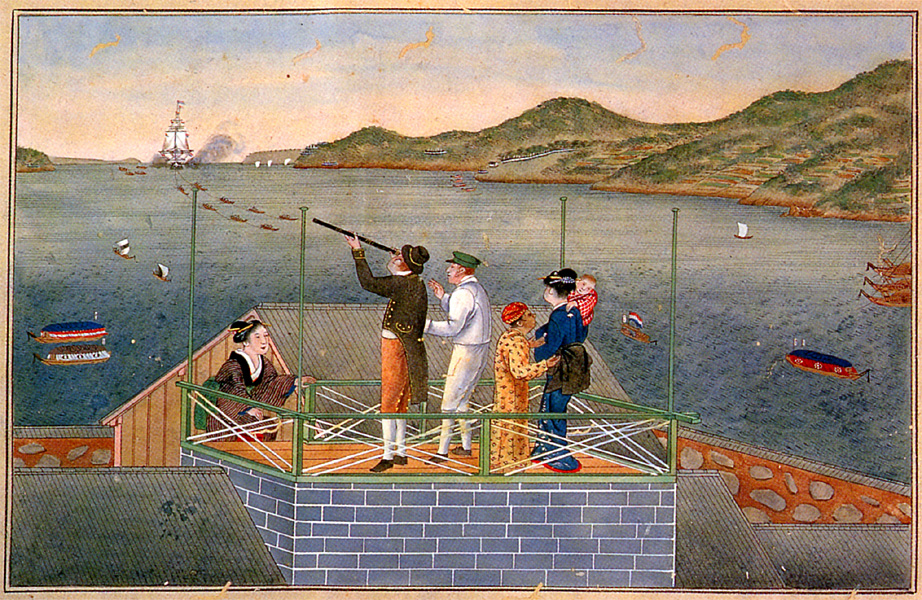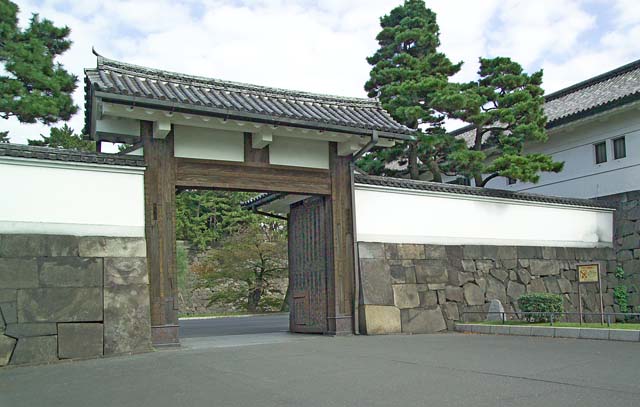|
Kusumoto Ine
Kusumoto Ine (, 31 May 182727 August 1903; born Shiimoto Ine ) was a Japanese physician. She was the daughter of Kusumoto Taki, who was a courtesan from Nagasaki; and the German physician Philipp Franz von Siebold, who worked on Dejima, an island foreigners were restricted to during Japan's long period of seclusion from the world. Ine was also known as O-Ine and later in life took the name Itoku (). In Japanese she is often called Oranda O-Ine ("Dutch O-Ine") for her association with Dejima and its Dutch-language Western learning. She was the first female doctor of Western medicine in Japan. Siebold was banished from Japan in 1829 but managed to provide for Ine and her mother and arranged for his students and associates to care for them. Ine's reputation grew after she became a doctor of Western medicine, and she won the patronage of the feudal lord Date Munenari. She studied in various parts of Japan under numerous teachers, one of whom impregnated her—likely having ... [...More Info...] [...Related Items...] OR: [Wikipedia] [Google] [Baidu] |
Nagasaki
is the capital and the largest city of Nagasaki Prefecture on the island of Kyushu in Japan. It became the sole port used for trade with the Portuguese and Dutch during the 16th through 19th centuries. The Hidden Christian Sites in the Nagasaki Region have been recognized and included in the UNESCO World Heritage List. Part of Nagasaki was home to a major Imperial Japanese Navy base during the First Sino-Japanese War and Russo-Japanese War. Near the end of World War II, the American atomic bombings of Hiroshima and Nagasaki made Nagasaki the second and, to date, last city in the world to experience a nuclear attack (at 11:02 am, August 9, 1945 'Japan Standard Time (UTC+9)'). , the city has an estimated population of 407,624 and a population density of 1,004 people per km2. The total area is . History Nagasaki as a Jesuit port of call The first contact with Portuguese explorers occurred in 1543. An early visitor was Fernão Mendes Pinto, who came from S ... [...More Info...] [...Related Items...] OR: [Wikipedia] [Google] [Baidu] |
Yūkaku
were legal red-light districts in Japanese history, where both brothels and prostitutes - known collectively as , the higher ranks of which were known as - recognised by the Japanese government operated. ��郭��大百科事典. 第25巻』 (平凡社, 1939) Though prostitution was, officially, legal to engage in and pay for only in these areas, there were a number of places where prostitutes and brothels operated illegally, known as , the generic name for all unlicensed red-light districts other than Yoshiwara (later including both Shimabara and Shinmachi).平田(1997)109頁。 In January 1946, GHQ issued an order (SCAPIN 642) nationwide to abolish Japan's legalised system of prostitution, with brothels in the areas having to change their names to either that of or , with the being renamed as districts. Following this, the was passed in 1956, before being fully enforced two years later in 1958; though the law did not criminalise all forms of sex work, the sale of ... [...More Info...] [...Related Items...] OR: [Wikipedia] [Google] [Baidu] |
Fukuzawa Yukichi
was a Japanese educator, philosopher, writer, entrepreneur and samurai who founded Keio University, the newspaper '' Jiji-Shinpō'', and the Institute for Study of Infectious Diseases. Fukuzawa was an early advocate for reform in Japan. His ideas about the organization of government and the structure of social institutions made a lasting impression on a rapidly changing Japan during the Meiji period. He appears on the current 10,000- Japanese yen banknote. Early life Fukuzawa Yukichi was born into an impoverished low-ranking samurai (military nobility) family of the Okudaira Clan of Nakatsu Domain was a Japanese domain of the Edo period. It was associated with Buzen Province in modern-day Ōita Prefecture on the island of Kyushu. The domain was centered at Nakatsu Castle in what is now Nakatsu, Ōita. In the han system, Nakatsu was a ... (present-day Ōita Prefecture, Ōita, Kyushu) in 1835. His family lived in Osaka, the main trading center for Japan at the ... [...More Info...] [...Related Items...] OR: [Wikipedia] [Google] [Baidu] |
Ovariotomy
Oophorectomy (; from Greek , , 'egg-bearing' and , , 'a cutting out of'), historically also called ''ovariotomy'' is the surgical removal of an ovary or ovaries. The surgery is also called ovariectomy, but this term is mostly used in reference to animals, e.g. the surgical removal of ovaries from laboratory animals. Removal of the ovaries of females is the biological equivalent of castration of males; the term ''castration'' is only occasionally used in the medical literature to refer to oophorectomy of women. In veterinary medicine, the removal of ovaries and uterus is called ovariohysterectomy (spaying) and is a form of sterilization. The first reported successful human oophorectomy was carried out by (Sir) Sydney Jones at Sydney Infirmary, Australia, in 1870. Partial oophorectomy or ovariotomy is a term sometimes used to describe a variety of surgeries such as ovarian cyst removal, or resection of parts of the ovaries. This kind of surgery is fertility-preserving, although ... [...More Info...] [...Related Items...] OR: [Wikipedia] [Google] [Baidu] |
Kusumoto Takako And Mise Shūzō
Kusumoto (written: 楠本) is a Japanese surname. Notable people with the surname include: *, Japanese physician *Roy Kusumoto Roy Kusumoto is an American businessman who founded Solectron in 1977. He started the company as a small assembly shop that under the input of Winston Chen and Ko Nishimura would grow into an electronics manufacturing giant with over $20 billion in ..., American businessman *, Japanese footballer {{surname Japanese-language surnames ... [...More Info...] [...Related Items...] OR: [Wikipedia] [Google] [Baidu] |
Bakufu
, officially , was the title of the military dictators of Japan during most of the period spanning from 1185 to 1868. Nominally appointed by the Emperor, shoguns were usually the de facto rulers of the country, though during part of the Kamakura period, shoguns were themselves figureheads, with real power in hands of the Shikken of the Hōjō clan. The office of shogun was in practice hereditary, though over the course of the history of Japan several different clans held the position. The title was originally held by military commanders during Heian period in the eighth and ninth centuries. When Minamoto no Yoritomo gained political ascendency over Japan in 1185, the title was revived to regularize his position, making him the first shogun in the usually understood sense. The shogun's officials were collectively referred to as the ; they were the ones who carried out the actual duties of administration, while the Imperial court retained only nominal authority.Beasley, William G ... [...More Info...] [...Related Items...] OR: [Wikipedia] [Google] [Baidu] |
Ansei
was a after ''Kaei'' and before ''Man'en''. This period spanned the years from November 1854 through March 1860. The reigning emperor was . Change of era * November 27, 1854 (): The new era name of ''Ansei'' (meaning "tranquil government") was created to herald the beginning of a peaceful period. The impetus and explanation for this change of era names was said to have been the burning of the Palace in Kyoto in the preceding summer.Satow, Ernest Mason. (1905) ''Japan 1853–1864, Or, Genji Yume Monogatari'', p. 11./ref> The new era name was derived from an hortatory aphorism: "Rule peacefully over the masses, then the ruler will remain in his place" (庶民安政、然後君子安位矣). Although the notion seems appealing, the arrival of the Black Ships and Commodore Matthew C. Perry is not specifically recognized as a factor in the change of era names. Events of the ''Ansei'' era * 1854 (''Ansei 1''): The Ansei-Tōkai Quake (安政東海地震, ''Ansei Tōkai Jish ... [...More Info...] [...Related Items...] OR: [Wikipedia] [Google] [Baidu] |
Treaty Port
Treaty ports (; ja, 条約港) were the port cities in China and Japan that were opened to foreign trade mainly by the unequal treaties forced upon them by Western powers, as well as cities in Korea opened up similarly by the Japanese Empire. Chinese treaty ports The British established their first treaty ports in China after the First Opium War by the Treaty of Nanking in 1842. As well as ceding the island of Hong Kong to the United Kingdom in perpetuity, the treaty also established five treaty ports at Shanghai, Canton ( Guangzhou), Ningpo (Ningbo), Foochow ( Fuzhou), and Amoy (Xiamen). The following year the Chinese and British signed the Treaty of the Bogue, which added provisions for extraterritoriality and the most favored nation status for the latter country. Subsequent negotiations with the Americans (1843 Treaty of Wanghia) and the French (1844 Treaty of Whampoa) led to further concessions for these nations on the same terms as the British. The second group ... [...More Info...] [...Related Items...] OR: [Wikipedia] [Google] [Baidu] |
Convention Of Kanagawa
The Convention of Kanagawa, also known as the Kanagawa Treaty (, ''Kanagawa Jōyaku'') or the Japan–US Treaty of Peace and Amity (, ''Nichibei Washin Jōyaku''), was a treaty signed between the United States and the Tokugawa Shogunate on March 31, 1854. Signed under threat of force, it effectively meant the end of Japan's 220-year-old policy of national seclusion ('' sakoku'') by opening the ports of Shimoda and Hakodate to American vessels. It also ensured the safety of American castaways and established the position of an American consul in Japan. The treaty precipitated the signing of similar treaties establishing diplomatic relations with other Western powers. Isolation of Japan Since the beginning of the 17th century, the Tokugawa Shogunate pursued a policy of isolating the country from outside influences. Foreign trade was maintained only with the Dutch and the Chinese and was conducted exclusively at Nagasaki under a strict government monopoly. This "Pax Tokugawa ... [...More Info...] [...Related Items...] OR: [Wikipedia] [Google] [Baidu] |
Daimyō
were powerful Japanese magnates, feudal lords who, from the 10th century to the early Meiji period in the middle 19th century, ruled most of Japan from their vast, hereditary land holdings. They were subordinate to the shogun and nominally to the emperor and the '' kuge''. In the term, means 'large', and stands for , meaning 'private land'. From the ''shugo'' of the Muromachi period through the Sengoku to the ''daimyo'' of the Edo period, the rank had a long and varied history. The backgrounds of ''daimyo'' also varied considerably; while some ''daimyo'' clans, notably the Mōri, Shimazu and Hosokawa, were cadet branches of the Imperial family or were descended from the ''kuge'', other ''daimyo'' were promoted from the ranks of the samurai, notably during the Edo period. ''Daimyo'' often hired samurai to guard their land, and they paid the samurai in land or food as relatively few could afford to pay samurai in money. The ''daimyo'' era ended soon after the Meiji ... [...More Info...] [...Related Items...] OR: [Wikipedia] [Google] [Baidu] |
Date Munenari (coloured)
__NOTOC__ The Marquis was the eighth head of the Uwajima Domain during the Late Tokugawa shogunate and a politician of the early Meiji era. Early life Munenari was born in Edo, the 4th son of the hatamoto Yamaguchi Naokatsu. Munenari, then known as Kamesaburō 亀三郎, was a candidate for adoption by the heirless 7th generation Uwajima lord Date Munetada because Naokatsu's father was the 5th Uwajima lord, Date Muratoki. Clan leader Munenari succeeded to headship in 1844. The ''tairō'' Ii Naosuke ordered Munenari's retirement in 1858. He was placed under house arrest. He returned to prominence in the subsequent years of political maneuvering in Kyoto, as a member of the conciliatory kōbu-gattai (公武合体 ''union of court and bakufu'') party. Late in Bunkyū 3 (1863), as a proponent of kōbu-gattai, he was made a member of the imperial advisory council (''sanyō-kaigi'' 参与会議), together with Matsudaira Katamori and other like-minded lords. National leader ... [...More Info...] [...Related Items...] OR: [Wikipedia] [Google] [Baidu] |
Okayama Domain
The was a Japanese domain of the Edo period. It was associated with Bizen Province in modern-day Okayama Prefecture.">DF_18_of_80">"Ikeda"_at_''Nobiliare_du_Japon'',_p._14_[PDF_18_of_80/nowiki>_retrieved_2013-4-25. # .html"_;"title="DF_18_of_80">"Ikeda"_at_''Nobiliare_du_Japon'',_p._14_[PDF_18_of_80/nowiki>">DF_18_of_80">"Ikeda"_at_''Nobiliare_du_Japon'',_p._14_[PDF_18_of_80/nowiki>_retrieved_2013-4-25. #Ikeda_Tadatsugu">Tadatsugu # .html"_;"title="DF_18_of_80">"Ikeda"_at_''Nobiliare_du_Japon'',_p._14_[PDF_18_of_80/nowiki>">DF_18_of_80">"Ikeda"_at_''Nobiliare_du_Japon'',_p._14_[PDF_18_of_80/nowiki>_retrieved_2013-4-25. #Ikeda_Tadatsugu">Tadatsugu #Ikeda_Tadakatsu">Tadakatsu *Ikeda_clan,_1632–1871_(''tozama'';_315,000_''koku'') # .html"_;"title="DF_18_of_80">"Ikeda"_at_''Nobiliare_du_Japon'',_p._14_[PDF_18_of_80/nowiki>">DF_18_of_80">"Ikeda"_at_''Nobiliare_du_Japon'',_p._14_[PDF_18_of_80/nowiki>_retrieved_2013-4-25. #Ikeda_Tadatsugu">Tadatsugu #Ikeda_Tadakatsu">Tadakatsu ... [...More Info...] [...Related Items...] OR: [Wikipedia] [Google] [Baidu] |






